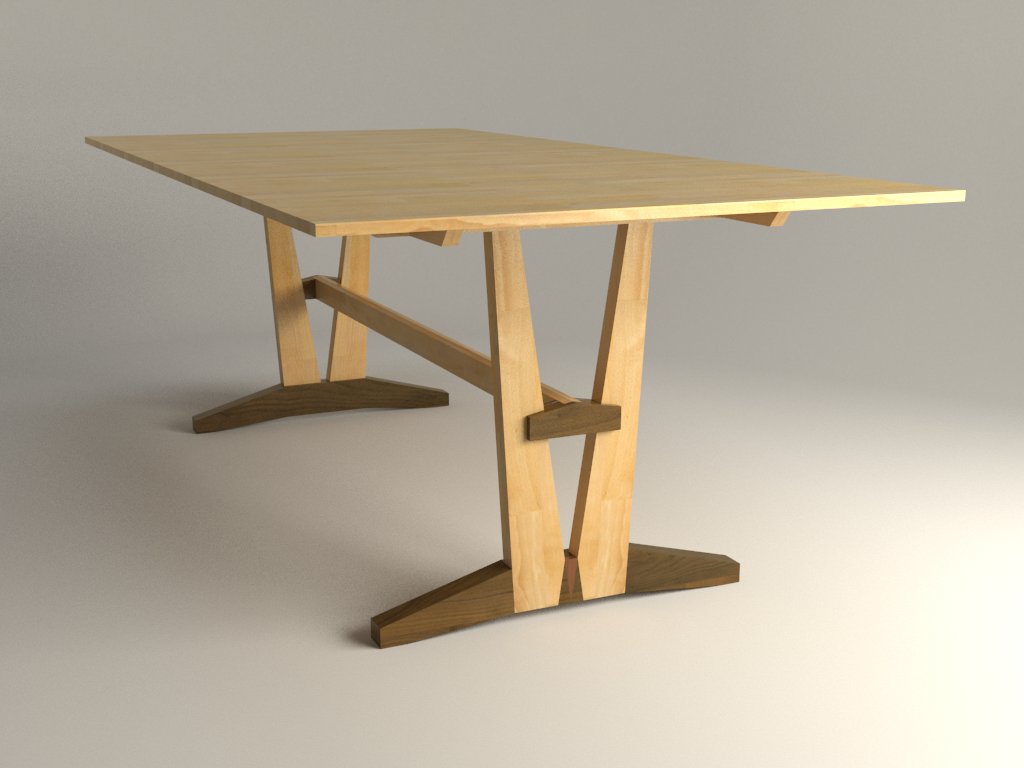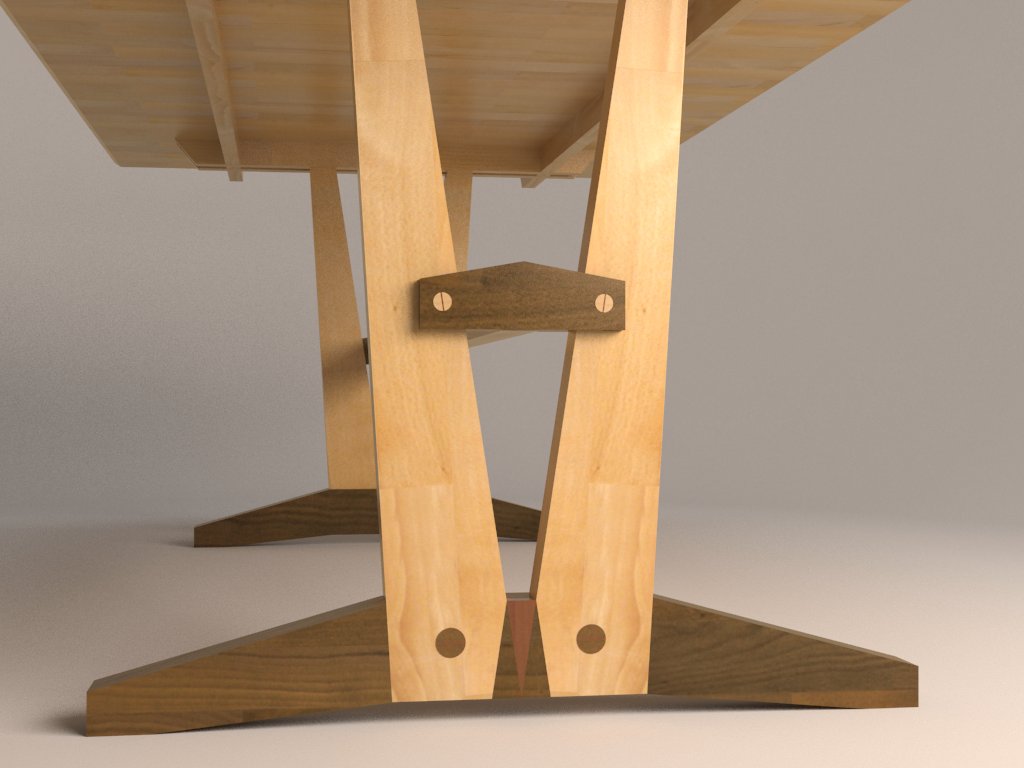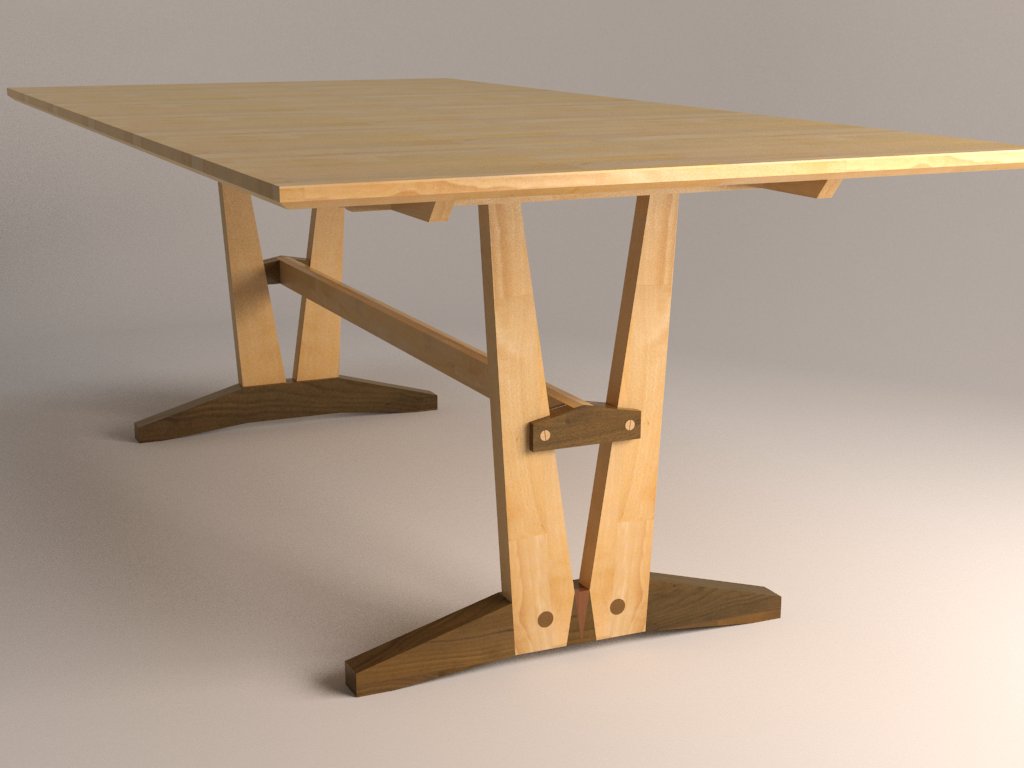WIP: trestle kitchen table
-
NICE. I Like the kitchen too, though one might need some respite from the color and I guess the cabinets aren't done.
I like the shape of the legs as seen on the near side of the last post. The shapes look less cut-off and more integrated. But, what would the joint be?
-
Peter, based on the that latest render, the joints would be half laps or as the Brits would say, halving joints.
-
Thanks Peter! Yes, Dave is right, the idea is a half-lap to emphasize the vertical. Quite right about the thinner top. Here it is with 1x boards. Might not need the edge bevel with this one, dunno. Tried another version with of the foot design as well.

-
Andy, the thinner top is better. I think about a 1/4-in. chamfer would be better on the top.
I like the idea of the half-laps but something bugs me about the foot assembly. I can't quite put my finger on it. Suppose the legs were thicker and so were the feet. Then get rid of the inverted T. I think it also looks flat-footed. How about cutting a very shallow vee in the bottom of the foot leaving pads about 2 in. long at the ends. That'll help to lift the table.
-
Still agree about the feet. 6/4 or 8/4 walnut is easy enough to source You could try a bridle joint to keep the maple visible if you wish. And I second Dave's notion to relieve the underside to create a samller footprint- much less dependant on a perfectly flat floor...but coming along nicely
-
Thanks for the ideas. Here's a revision with the relief under the feet and thicker wood for that piece. That's a good point that the foot may need more than a half-lap of wood continuing through, though with a thicker section it may work ok. I definitely like it better with more simple pieces than were I was going with adding the T to the foot.

-
Much better. I think your half laps will be just fine but you could do a really ninja thing and make them dovetailed.

-
Nice, I'll take one

-
Thanks guys! Much appreciated

-
Whenever I think of a trestle table, I always think of their ability to be knocked down.
You could do a real elegant job of this on this table by having the darker wood on the end of your stretcher mortised over the "v" legs. If the mortise were angled to match the "v", then as you pushed it down it would lock the legs in. Holes in both the stretcher end, and the leg could have pegs, and would really lock the them, particularly if the leg hole was slightly offset lower than a snug fitting stretcher.
Nice piece. -
Thanks Dale. I think I get what you are explaining about the added structural rigidity. I'm wondering since it's already triangulated, most of the forces are going be at the joint with the feet. (Acutally, which is a god reason in favor of a mortised connection instead of a lap connection... the lap could just "pop" out of joint if it's not secured well enough.)
-
I agree Andy, the more faces in a glue joint the stronger the joint. So if the mortise is shouldered, you have a potential 9 faces.
-
The mortise is what I suggested at first but I like the lap joint. Any faces which include end grain are basically write offs as far as strength so in a mortise and tenon joint you still really have only two good gluing surfaces. With the strength of glues today, the wood will be weaker than the glue joint I doubt you'd have any problem with the lap. If you wanted to maintain the the look of the lap (which I like) but you want to add some mechanical security to the joint in addition to the glue, you could do the dovetailed thing. Bevel the sides of the parts so the legs will only slide in from the top.
-
@dave r said:
Bevel the sides of the parts so the legs will only slide in from the top.
 Great idea, I like it! Now I understand what you mean about dovetailing. I was trying to figure out what the orientation of the dovetail would be. So this way, you would see the profile of the dovetail from underneath.
Great idea, I like it! Now I understand what you mean about dovetailing. I was trying to figure out what the orientation of the dovetail would be. So this way, you would see the profile of the dovetail from underneath. -
Yes. Exactly. Fromt the front it would look basically the same as it does now.
I should have draw it up for you. Sorry about that.
-
There certainly is nothing wrong with the lap, and as Dave say's with the glues we now use there should be no problem.
However I would like to discuss why I think a shouldered tenon is a stronger joint. This would be and end grain to side grain joint, which is stronger than an end grain to end grain joint, but weaker than a side grain to side grain joint.
An end grain to side grain joint is quite strong in compression and tension. It's weakness lies under racking stresses. This is where a (well executed) shouldered tenon comes in and supplies the mechanical advantages needed to not allow the joint to rack.
On the other hand the 1/2 lap, although essentially a side grain to side grain joint except that in this situation the grains are running perpendicular to each other. According to my Hero Bruce Hoadley..."The conflict between dimensional change along the grain and across the grain (especially where tangential opposes longitudinal direction) may become more important than the stress/strength of the original joint. The potential self destructiveness of such joints should always be anticipated"
This is extreme, and most likely will not take place in the joint of the trestle table, but what may take place is the differences in the way the woods dimensional properties change in response to changing moisture conditions, may cause the joint to open up slightly because the legs will shrink more "across" their grain, than the feet will "along" their grain.
Sorry, don't want to take this too far sideways, but my cabinet making teacher, my father, pounded stuff like this into me. -
PS
As for the dovetail, that's a great idea.
-
Dale, yeah, I certainly get the cross-grain issue. Seems like a joint that shouldn't rely exclusively on glue. I've got a bit of an unconventional idea - doing something kind of like a double mortise, but with a lap/ mortise combo. Here is my model file, I drew the joint in SU. Also, in looking at it, there doesn't seem to be a good way to do the dovetail - since there's not much material between the verticals, and it would take extra material to dovetail on the outside sides. Anyhow, curious what you think.


-
Andy, I really like this now. I haven't had time to download the SKP but I'll look later.
-
I agree, that looks great!
Advertisement







